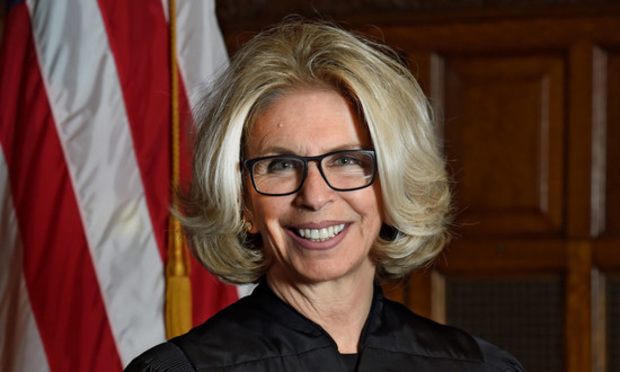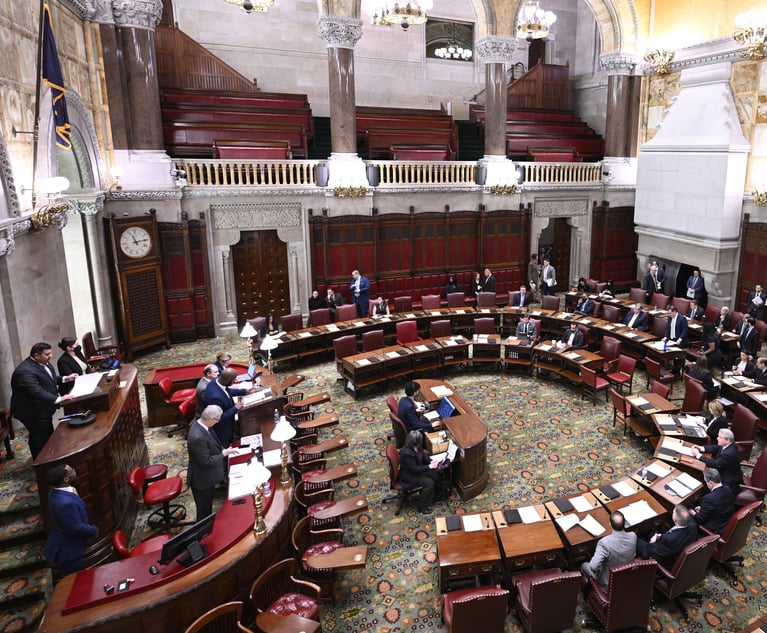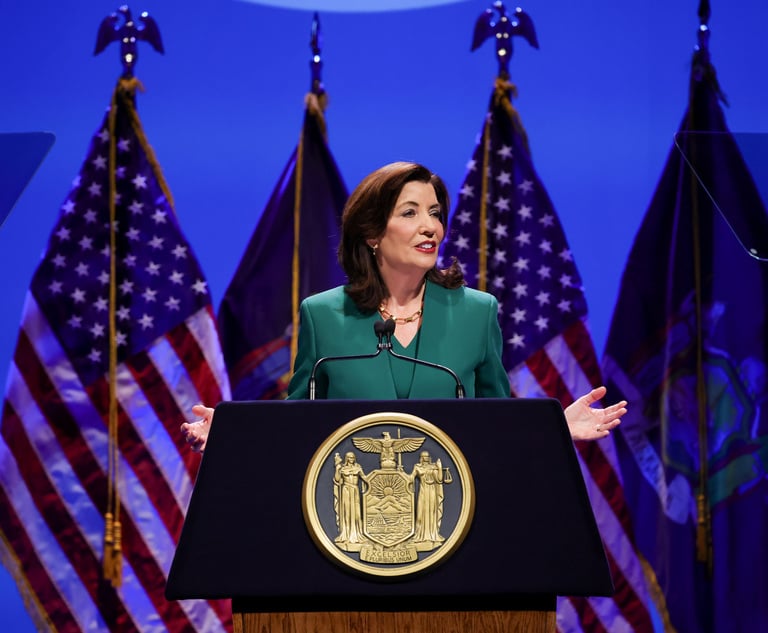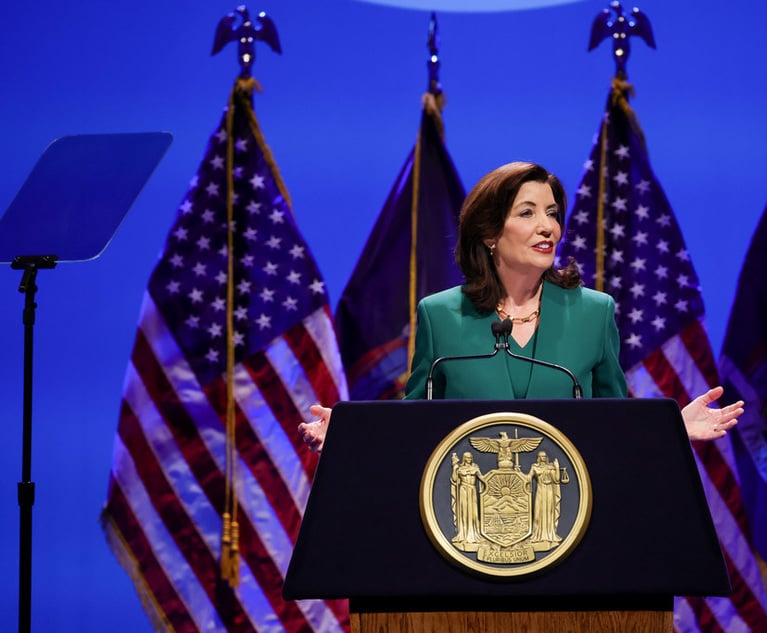DiFiore Unveils Detailed Proposal for Lawmakers to Overhaul New York's Trial Courts
The reform would also give the Legislature more power to expand the state judiciary in some ways.
September 25, 2019 at 05:08 PM
6 minute read
 Chief Judge Janet DiFiore
Chief Judge Janet DiFiore
Chief Judge Janet DiFiore on Wednesday unveiled a comprehensive proposal to overhaul the state's trial court system, which would consolidate the current structure of 11 separate trial courts to a three-tier model intended to streamline and simplify litigation in New York.
The reform would require an amendment to the state constitution, which is done through two votes by two consecutive classes of the state Legislature, followed by approval from voters.
Lawmakers in Albany haven't had much of an appetite in recent years for reforming the state's trial court system, a measure that's been floated by state court officials for decades. DiFiore said Wednesday that it's time for the Legislature to come around to the idea.
"We are long overdue to amend our State Constitution to create a streamlined trial court system, a structure organized in a manner that most effectively and efficiently addresses the modern-day justice needs of New Yorkers," DiFiore said.
If the Legislature takes the first step on the measure during next year's legislative session, it could be on the ballot for voters as early as 2021. The plan, as outlined by DiFiore, would be phased in over five years.
The reform would also give the Legislature more power to expand the state judiciary in some ways.
It would eliminate a cap on the number of state Supreme Court judgeships that was enshrined in the state constitution through a formula more than a century ago. That would allow the Legislature to add more judicial positions if the need is present, such as in Manhattan.
"It's a very high-volume jurisdiction that could benefit from more judges," said Chief Administrative Judge Lawrence Marks.
The Legislature would also be authorized to review, every 10 years, whether the number of Appellate Division Departments should be modified to accommodate the state's justice system. New York currently has four state appellate courts, but some have pushed for at least one more.
"Today, the Second Department has roughly half the population of the state," Marks said. "So, we could benefit from an additional appellate department."
Aside from that, DiFiore's plan is designed as a sort-of hybrid system of what New York has now, and a more condensed tier of trial courts, which is common in other states.
New York currently has 11 separate trial courts, ranging from state Supreme Court to City Court. Despite its name, the state Supreme Court is the trial court level in New York, under the Appellate Division and the Court of Appeals, the state's highest court.
Each of the state's trial courts have a different purpose, which can often be complicated for litigants, particularly when a case falls under the jurisdiction of multiple courts.
DiFiore's plan would consolidate those courts into a simplified three-level structure: a centralized state Supreme Court, a Municipal Court, and the current town and village courts.
The state Supreme Court would be formed under DiFiore's plan by eliminating many of the state's current trial courts and folding them into a unified entity. The state Court of Claims, County Courts, Family Courts, and Surrogate's Courts would all be nixed under the plan. Their justices would remain and become state Supreme Court justices.
The newly consolidated state Supreme Court would have six divisions: family, probate, criminal, state claims, commercial, and general.
The Municipal Court would be comprised of many of the state's more localized courts. It would be formed after a phaseout of the New York City Civil and Criminal Courts, District Courts on Long Island, and the 61 city courts in upstate New York.
While established as a statewide entity, the Municipal Court would act as a separate court in each location where it would replace something else. The Housing Part of the New York City Civil Court would also become part of the Municipal Court.
Like how the state's trial courts are structured now, the Municipal Court would handle lower-level crimes and civil cases, while the state Supreme Court would handle higher-level charges and claims.
The consolidation of those two tiers would happen through a so-called merger-in-place method, meaning that each judicial position would retain the same term and process of joining the bench as it had before.
State Supreme Court justices, unless they're in the position on an acting basis, are elected by voters in each jurisdiction. Other judges, such as those on the Court of Claims or New York City Criminal Court judges, are appointed to the bench.
While their title would change under DiFiore's proposal, the length of their term and how they end up on the bench wouldn't. A judicial position previously on the Court of Claims would still have a nine-year term, and would still be appointed by the governor, for example.
"With respect to the Supreme Court, where we would merge these other trial courts that exist into an expanded Supreme Court, our proposal wouldn't change how judges are selected," Marks said.
They designed the plan that way to avoid the debate in New York over whether judges should be elected or appointed to the bench, he said. The state Office of Court Administration, as an institution, doesn't have a position on that subject, according to Marks.
Those two tiers would be accompanied by the current system of town and village courts, a third level that wouldn't change under DiFiore's proposal.
State Sen. Brad Hoylman, D-Manhattan, and Assemblyman Jeffrey Dinowitz, D-Bronx, who serve as chairmen of the judiciary committees in their respective chambers, said earlier this year that they would be supportive of reforming the state's trial courts.
Hoylman, in a statement Wednesday, was optimistic about the proposal's chances.
"With a new majority in the State Senate and the support of a diverse coalition of over one hundred legal, business and community organizations from across the state, we can finally address an issue that has been blocked in the Senate for consideration for over forty years," Hoylman said.
It remains to be seen whether they'll be able to convince their colleagues to move the plan, which has been floated to the Legislature in various forms for decades. Next year's legislative session is scheduled to begin in January.
READ MORE:
NY Lawmakers See Court Reform, Assigned Counsel Rate Hike With Favor
DiFiore Renews Call for Lawmakers to Restructure NY Court System
Report Argues Town and Village Justices Ignore Plight of Poor Defendants Facing Fines
This content has been archived. It is available through our partners, LexisNexis® and Bloomberg Law.
To view this content, please continue to their sites.
Not a Lexis Subscriber?
Subscribe Now
Not a Bloomberg Law Subscriber?
Subscribe Now
NOT FOR REPRINT
© 2025 ALM Global, LLC, All Rights Reserved. Request academic re-use from www.copyright.com. All other uses, submit a request to [email protected]. For more information visit Asset & Logo Licensing.
You Might Like
View All
Relaxing Penalties on Discovery Noncompliance Allows Criminal Cases to Get Decided on Merit
5 minute read
Bipartisan Lawmakers to Hochul Urge Greater Student Loan Forgiveness for Public-Interest Lawyers

'Playing the Clock'?: Hochul Says NY's Discovery Loophole Is to Blame for Wide Dismissal of Criminal Cases

So Who Won? Congestion Pricing Ruling Leaves Both Sides Claiming Victory, Attorneys Seeking Clarification
4 minute readTrending Stories
- 1New York-Based Skadden Team Joins White & Case Group in Mexico City for Citigroup Demerger
- 2No Two Wildfires Alike: Lawyers Take Different Legal Strategies in California
- 3Poop-Themed Dog Toy OK as Parody, but Still Tarnished Jack Daniel’s Brand, Court Says
- 4Meet the New President of NY's Association of Trial Court Jurists
- 5Lawyers' Phones Are Ringing: What Should Employers Do If ICE Raids Their Business?
Who Got The Work
J. Brugh Lower of Gibbons has entered an appearance for industrial equipment supplier Devco Corporation in a pending trademark infringement lawsuit. The suit, accusing the defendant of selling knock-off Graco products, was filed Dec. 18 in New Jersey District Court by Rivkin Radler on behalf of Graco Inc. and Graco Minnesota. The case, assigned to U.S. District Judge Zahid N. Quraishi, is 3:24-cv-11294, Graco Inc. et al v. Devco Corporation.
Who Got The Work
Rebecca Maller-Stein and Kent A. Yalowitz of Arnold & Porter Kaye Scholer have entered their appearances for Hanaco Venture Capital and its executives, Lior Prosor and David Frankel, in a pending securities lawsuit. The action, filed on Dec. 24 in New York Southern District Court by Zell, Aron & Co. on behalf of Goldeneye Advisors, accuses the defendants of negligently and fraudulently managing the plaintiff's $1 million investment. The case, assigned to U.S. District Judge Vernon S. Broderick, is 1:24-cv-09918, Goldeneye Advisors, LLC v. Hanaco Venture Capital, Ltd. et al.
Who Got The Work
Attorneys from A&O Shearman has stepped in as defense counsel for Toronto-Dominion Bank and other defendants in a pending securities class action. The suit, filed Dec. 11 in New York Southern District Court by Bleichmar Fonti & Auld, accuses the defendants of concealing the bank's 'pervasive' deficiencies in regards to its compliance with the Bank Secrecy Act and the quality of its anti-money laundering controls. The case, assigned to U.S. District Judge Arun Subramanian, is 1:24-cv-09445, Gonzalez v. The Toronto-Dominion Bank et al.
Who Got The Work
Crown Castle International, a Pennsylvania company providing shared communications infrastructure, has turned to Luke D. Wolf of Gordon Rees Scully Mansukhani to fend off a pending breach-of-contract lawsuit. The court action, filed Nov. 25 in Michigan Eastern District Court by Hooper Hathaway PC on behalf of The Town Residences LLC, accuses Crown Castle of failing to transfer approximately $30,000 in utility payments from T-Mobile in breach of a roof-top lease and assignment agreement. The case, assigned to U.S. District Judge Susan K. Declercq, is 2:24-cv-13131, The Town Residences LLC v. T-Mobile US, Inc. et al.
Who Got The Work
Wilfred P. Coronato and Daniel M. Schwartz of McCarter & English have stepped in as defense counsel to Electrolux Home Products Inc. in a pending product liability lawsuit. The court action, filed Nov. 26 in New York Eastern District Court by Poulos Lopiccolo PC and Nagel Rice LLP on behalf of David Stern, alleges that the defendant's refrigerators’ drawers and shelving repeatedly break and fall apart within months after purchase. The case, assigned to U.S. District Judge Joan M. Azrack, is 2:24-cv-08204, Stern v. Electrolux Home Products, Inc.
Featured Firms
Law Offices of Gary Martin Hays & Associates, P.C.
(470) 294-1674
Law Offices of Mark E. Salomone
(857) 444-6468
Smith & Hassler
(713) 739-1250






